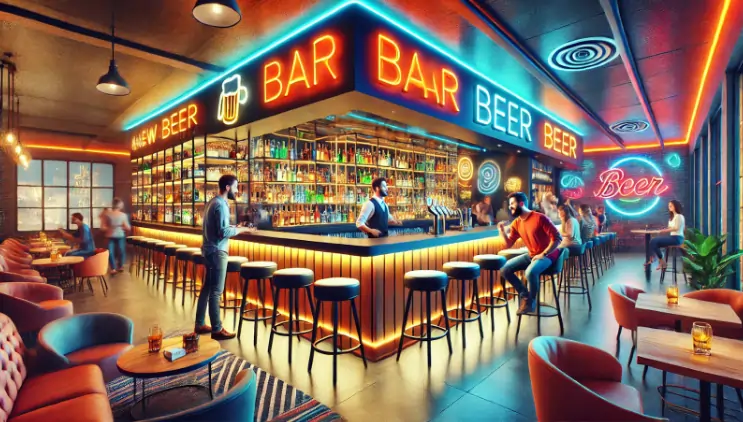Opening a new bar can be an exciting venture, but it comes with its fair share of challenges. From planning the concept to managing the day-to-day operations, there are numerous factors to consider to ensure your bar is successful. Here are some essential tips to help you navigate the process of launching your new bar and creating a vibrant, welcoming space for your customers.
Define Your Concept and Target Audience
Before you dive into the details of opening your bar, it’s crucial to have a clear concept and target audience in mind. The concept will guide your decisions on decor, menu, and marketing, while understanding your target audience will help tailor your offerings to their preferences.
Creating a Unique Concept
- Theme and Ambiance: Decide on the overall theme and ambiance of your bar. Whether it’s a sophisticated cocktail lounge, a casual sports bar, or a trendy craft beer spot, your concept should reflect the atmosphere you want to create.
- Signature Drinks: Develop a menu that includes signature drinks and unique cocktails. This not only differentiates your bar from others but also gives customers a reason to return.
- Decor and Lighting: Pay attention to the decor and lighting to create a cohesive look. Consider using neon beer signs to add a vibrant and nostalgic touch that can enhance the ambiance.
Identifying Your Target Audience
- Demographics: Understand the demographics of your potential customers, such as age, gender, and income level. This will help you tailor your marketing efforts and menu offerings.
- Customer Preferences: Research the preferences and habits of your target audience. Are they more likely to enjoy craft beers, classic cocktails, or non-alcoholic beverages?
- Location Analysis: Analyze the location of your bar to ensure it aligns with your target audience. A high-traffic area with a mix of locals and tourists can provide a steady stream of customers.
Secure Necessary Permits and Licenses
Operating a bar requires various permits and licenses, which can vary depending on your location. It’s important to understand and comply with local regulations to avoid legal issues down the line.
Key Permits and Licenses
- Liquor License: Obtain a liquor license from your local government. The process can be lengthy and expensive, so start early.
- Business License: Ensure you have a business license to operate legally in your area.
- Health and Safety Permits: Comply with health and safety regulations by obtaining the necessary permits from local health departments.
Compliance and Inspections
Regularly review local regulations and stay updated on any changes to ensure ongoing compliance. Schedule routine inspections to maintain high standards of hygiene and safety.
Design an Inviting Space
The design of your bar plays a significant role in attracting and retaining customers. An inviting, comfortable space encourages patrons to stay longer and return frequently.
Interior Design Tips
- Comfortable Seating: Invest in comfortable seating options, such as cushioned bar stools, cozy booths, and lounge chairs.
- Lighting: Use a mix of ambient, task, and accent lighting to create a warm and welcoming atmosphere. Neon beer signs can add a fun and eye-catching element to your decor.
- Music and Entertainment: Curate a playlist that complements your bar’s theme and consider offering live music or DJ nights to enhance the customer experience.
Functional Layout
Design a layout that facilitates smooth operations. Ensure there is enough space behind the bar for staff to work efficiently and that customers have easy access to restrooms and exits.
Develop a Strong Marketing Plan
Effective marketing is crucial for attracting customers to your new bar. A well-thought-out marketing plan can help you build a loyal customer base and generate buzz around your opening.
Marketing Strategies
- Social Media: Leverage social media platforms to promote your bar. Share engaging content, such as behind-the-scenes videos, special promotions, and customer testimonials.
- Local Advertising: Invest in local advertising, such as flyers, posters, and ads in community newspapers or magazines. Collaborate with local influencers to reach a wider audience.
- Events and Promotions: Host events and promotions to attract new customers. Consider offering happy hour specials, themed nights, and grand opening celebrations.
Building a Brand
Develop a strong brand identity that reflects your bar’s concept and values. This includes creating a memorable logo, consistent color scheme, and a unique brand voice.
Hire and Train a Competent Staff
Your staff plays a vital role in the success of your bar. Hiring the right people and providing thorough training ensures excellent customer service and smooth operations.
Recruitment Tips
- Job Descriptions: Write clear and detailed job descriptions to attract qualified candidates.
- Interviews: Conduct thorough interviews to assess candidates’ skills, experience, and cultural fit.
- References: Check references to verify past performance and reliability.
Training Programs
- Customer Service: Train staff on the importance of excellent customer service, including communication skills, attentiveness, and handling complaints.
- Product Knowledge: Ensure bartenders and servers are knowledgeable about the menu and can make recommendations to customers.
- Safety and Compliance: Educate staff on health and safety regulations, responsible alcohol service, and emergency procedures.
Monitor Finances Closely
Managing finances effectively is crucial for the sustainability of your bar. Keeping track of expenses, sales, and profits helps you make informed decisions and avoid financial pitfalls.
Financial Management Tips
- Budgeting: Create a detailed budget that includes startup costs, ongoing expenses, and projected revenue.
- Inventory Management: Implement an inventory management system to track stock levels and minimize waste.
- Financial Software: Use financial software to streamline bookkeeping, payroll, and tax reporting.
Regular Reviews
Conduct regular financial reviews to assess performance and identify areas for improvement. Adjust your strategies as needed to ensure financial stability and growth.
Engage with the Community
Building a strong relationship with the local community can boost your bar’s reputation and attract loyal customers. Engaging with the community shows that you value their support and are committed to contributing positively.
Community Engagement Ideas
- Local Events: Participate in local events, such as festivals, fairs, and charity fundraisers. Sponsor or host events to increase visibility and goodwill.
- Collaborations: Partner with local businesses to create mutually beneficial promotions and partnerships.
- Customer Feedback: Encourage and act on customer feedback to improve your offerings and service. Showing that you listen to your customers builds trust and loyalty.
Conclusion
Opening a new bar is an exciting journey that requires careful planning, creativity, and dedication. By defining your concept, securing the necessary permits, designing an inviting space, developing a strong marketing plan, hiring competent staff, monitoring finances, and engaging with the community, you can set the foundation for a successful and thriving establishment. Remember, attention to detail and a commitment to providing an exceptional customer experience will set your bar apart and ensure its long-term success. Cheers to your new venture!














